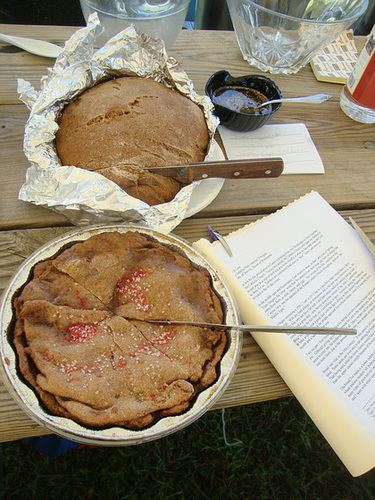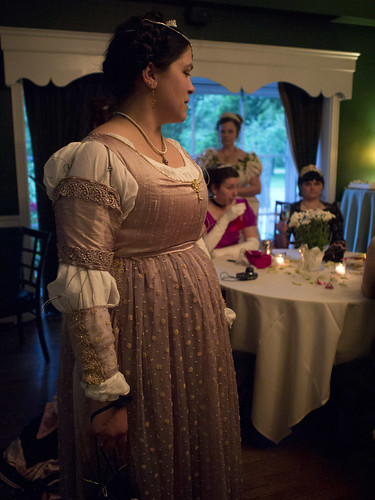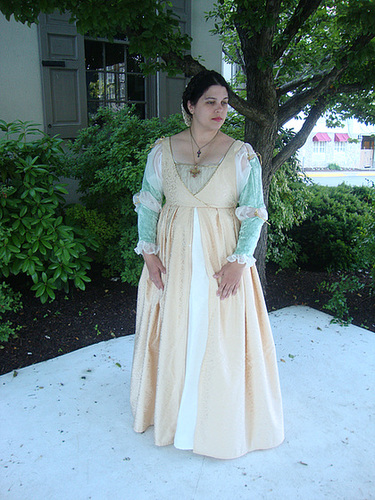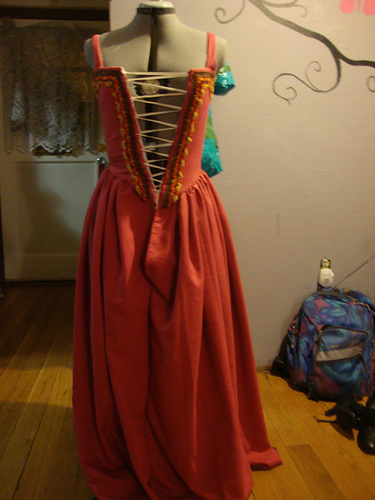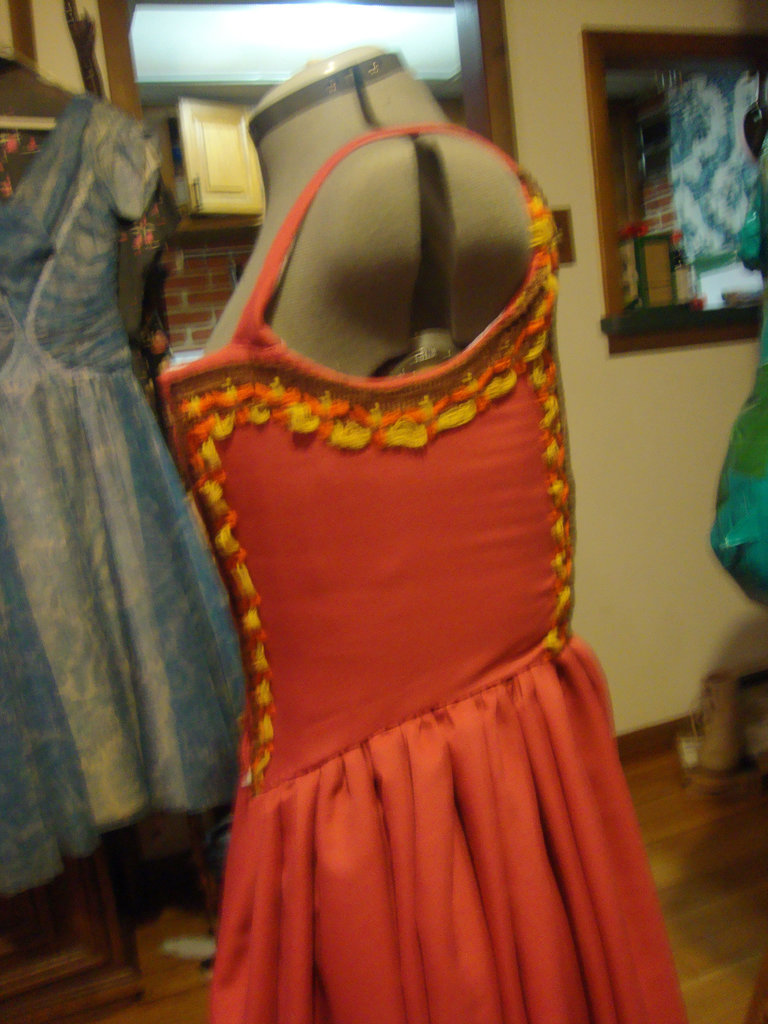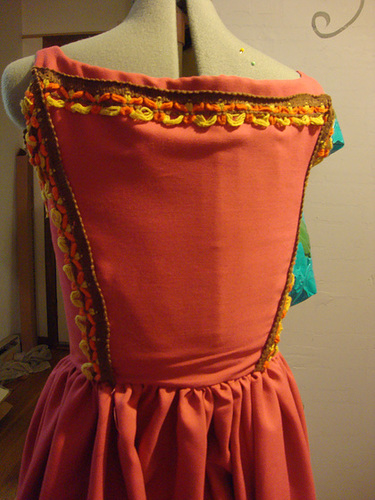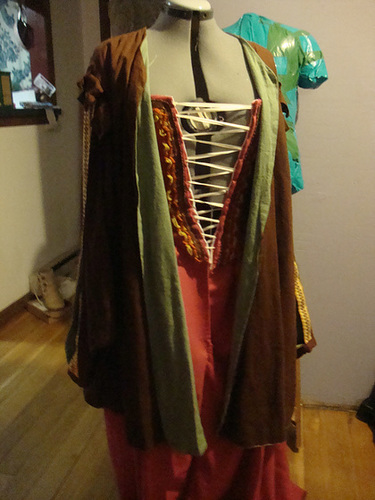Below is my documentation for my entry into the Religious A&S that was held in June 29th 2013 at Storvik Novice. The first judge was less than kind. His first words were "Well anyone who knows how to cook would know this is wrong" upon seeing that the filling to the apple pie was watery. I was in a hurry an put too much brown sugar in it. Not a big deal, normally, but when I tried to explain that no, it wasn't because the apples weren't cooked right - his explanation- but because I put too much brown sugar, he got even more huffy and declared "It's still wrong!" and went all Gordon Ramesy on my apple pie. Er...this is a Novice tourney? I've been cooking medieval style for two years? And that is NOT the way a judge should act - particularly when you are showing someone else around. The saddest part is that it wasn't just my entry. He went crazy when the individual who made the sekanjabin had they syrup out and hadn't put out ready made sekanjabin, even though their documentation stated what they had done. He declared that "How dare they serve it to me like this!" No, seriously. Followed by a mini rant of how this is not how it is done and how they should have had it already watered down. 0_o? Umm...maybe it's just me, but I'd like to taste the syrup to see what the full flavor is. Plus, if he was serious, the water ten was only ten feet away. It wasn't like he could grab a glass and water it down himself...
Anyway, the other judges seemed nicer and I did get a lot of compliments on the bread from everyone else. The lady running A&S "stole" the bread and was eating it as her lunch. So, clearly, it wasn't a total loss.
I will add pictures later today but I wanted to get my documentation up. Here it is! It's hardly perfect but this was just to have something that explained -quickly- what I was doing and why.
Lent is a 40-day period prior to Easter extending from Ash Wednesday to Holy Saturday in the Catholic Church. During this period, the Catholic Church calls upon the faithful to fast and pray as a sign of faith but also to be mindful of what we have and what the Lord has done for us. Sundays are considered feast days (a "mini" Easter) and were not included in the 40 day count.
In the middle ages and Renaissance, Lent meant no meat, no diary, and a lot of fasting. "Pope Gregory the Great
wrote that 'We abstain from flesh meat, and from all things that come from flesh, as milk, cheese, and eggs.'
This version of the fast,
codified in the
Corpus Juris, was the standard of the Roman Catholic Church throughout
most of
the Middle Ages."
I began recreating a 16th C Lent in 2012 due to a possibility that I might have a dairy allergy. With any food allergy, an elimination diet is the best way to discover it, so, my thought was why not have fun with it and learn about medieval cooking during Lent? I have learned a great deal - now having done some version of the 16th C Lenten diet twice- including the fact that, yes, I am allergic to dairy. However, doing the "medieval thing" helped me cope a great deal with the dairy allergy as they already figured out how to bake without milk in the middle ages and live without cheese - even if it was only for a month and a half out of the year.
Two recipes I find myself making a lot during Lent are a medieval bread recipe and apple pie.
Although giving up sweets is popular for Lent in the modern era, this idea didn't seem to enter into the medieval mind at all.
Many recipes call for sugar or honey.
This was most likely due to the amount of food they were already giving up.
Bread was vital in the 16th Century.
It was eaten by all classes and was central to the meal.
Some saints are even said to eat nothing but bread with herbs during their fasts.
That being said, what the lower classes would have enjoyed as a bread would be different than the upper classes simply because of the access to better milled wheat.
The bread I've made is a lower middle class type bread. The flour is a mix of whole wheat and our modern "all purpose" flour. In period, the flour could have been from many types of grain but my own food allergies prevent me from using two specific types and I went with what I knew I could eat.
Rather than yeast, as we would use in modern bread making, a starter was used in the middle ages/Renaissance.
My starter is relatively new at only three weeks old.
However, it has been bubbling up properly and I have already made two loaves with it.
All a starter is is fermented dough.
I used half flour/half water, place it in a jar, and cover the jar with a paper towel or a piece of cloth.
This way, air can still get to the dough but dust and grime stay out.
Every other day, I add more flour and more water as necessary to keep the dough bubbly and happy.
My recipe is based on the instructions given by Jean le Renaud de Pyranees.
Bread in Lent
3 cup flour
2 tablespoons olive oil
1 tablespoon honey
1 teaspoon salt
1/2 cup starter
Water as needed to make the dough
It isn't possible to mix all the flour in at once. Also, my measurements tend to be a bit funny since, rarely, are measurements given in medieval recipes. I tend to eyeball it and sometimes decide that it just needs a bit more honey than it really does.
First, I mixed up the starter, olive oil, honey, and salt. I then added 2 cups of the flour with a bit of water to form the dough. Once I had a decent dough, I took it out and kneaded it. At this point, I put out another 1/2 cup of flour to be kneaded into the bread. Once the dough begins to get tough, I placed it in a bowl to let it rise overnight.
The next day, I kneaded it again with the remaining 1/2 cup of flour and let it rise overnight again, this time on a cooking sheet. In the morning, I put the risen dough in the oven set for 380F for 35 minutes.
The bread is to be eaten with olive oil and herbs as is said the saints did and how bread is still eaten in the Mediterranean.
Apple Pie
Apple Pie is found, in some form, in nearly every medieval cookbook I have seen. In a 15th C Italian cookbook, the following recipe for apple pie is written:
Tartare Alla Franzesa de Pome. Fa cocere le pome quale tu vorai ho in aqua ho in mosto cotto, ho in uno tegamo al forno ho sotto le braxe; poi piglia pignoli stati a moglio in aqua una notte, che non siano ranzi, he pistali bene cum le pome; poi piglia assai zucaro he poco de canella, uno poco de zenzaro he un poco de zaffrano, he uno bichero de ova de luzo bene piste he passate per la stamegna, he miscola tute queste cose insieme he passa per la stamegna cm aqua rosada ho altra aqua; poi fa una pasta pigliando zucaro, farina, olio, aqua he sale, he miscola insieme he fa questa pastal, poi distendela sopra lo fondo de una padella bassa, he poi poneralli dentro questa tale compositione che non sia alta piu de uno digito; poi falla cocere a lo forno ho al foco como he dito de le altre torte; poi, quando sera quasi cotta, piglia nevole he spolvarizale de sopra questa Tartara - che siano fate le dite nevole cum bono zucaro; he quando sera cotta, getta de sopra zucaro he aqua rosa.
French-Style Apple Tart. Cook whatever apples you want, whether in water or in must syrup, whether in a baking dish in the oven or under the coals; then get pinenuts that have soaked a night in water, and are not rancid, grind them up with the apples; get a lot of sugar, a little cinnamon, a little ginger, a little saffron and a beaker of ground and strained pike eggs, and mix and strain everything with rosewater or some other water; then make a dough of sugar, flour, oil, water and salt, mix them together to make the dough, spread it over the bottom of a low pan, and put the mixture in so that it is no more than a finger deep; cook it in the oven or on the fire as is directed for the other tortes; when almost cooked, get wafers, crumble them over the Tart - those wafers should be made with good sugar; when cooked, garnish with sugar and rosewater. (Italy, 15th C)
What I liked about this recipe was the description of the pie crust; it's a dough of sugar, flour, oil, water, and salt -perfect for Lent. However, the idea of pine nuts in an apple pie along with pike eggs didn't sound very appetizing to my modern pallet so I looked to other cookbooks for the filling.
There is a German recipe from the 16th C that sounds far more appetizing:
225. To make a good tart with roasted apples. Peel the apples and cut them into four pieces, cut out the cores, and put them in pot, which should be well covered, and let them stew in the pot. One should watch them frequently, so that they do not scorch. Afterwards spread them on the pastry shell, which should be made of good flour, and put a half pound of sugar and a half ounce of finely ground cinnamon therein.
Although German food and Italian food are very distinctly different, variations on this same theme - apples with cinnamon and sugar in a pie crust- are found in multiple cookbooks from multiple areas and eras.
Original recipe from Ancient Cookery, 1381:
For to make Tartys in Apples: Take good apples and good spices & figs and raisings and pears and when they are well braid colour with safron well and do it in a coffin and do it forth to bake well.
Original recipe from Curye on Inglysh:
Tak gode applys & gode spycis & figs & reysons & perys, & wan bey arn wel ybrayd colour wyb safroun wel & do yt in a cofyn, & do yt forth to bake wel.
- Hieatt, Constance B. and Sharon Butler. Curye on Inglysch. New York: Oxford University Press for The Early English Text Society, 1985.
1.65. To make pasties during Lent
Grind hundred walnuts and a small handfull of almonds very finely in a mortar. [With] this grind 20 good apples, well peeled, without core. Add powdered sugar, ginger and ground cinnamon, or use grains of paradise instead of ginger. Colour this mixture with some saffron.
Although each recipe calls for something slightly different, the core of the pie is the same - cooked apples with cinnamon, typically ginger, and sugar. Saffron is also frequently mentioned.
Given this, I used the following:
For the Crust:
2 cups flour
Generous 1/2 cup of light brown sugar
1 tablespoon olive oil
1 teaspoon salt
1/2 cup of water with a pinch of saffron
I mixed the following together to get a basic dough. I kept adding more sugar to make it sweet so I'm not entirely sure how much really went in. I split the dough in half after kneading it for a few minutes - one pile for the bottom crust and the other for the top. I smoothed out the bottom crust and finger pinched it into the pie pan. I set the oven to 375f and baked it for 10 minutes.
For the filling:
4-5 apples
1 tablespoon of cinnamon
3/4 a cup or so of brown sugar
1 teaspoon ginger
After slicing and peeling the apples, I put them in a pot to boil. Once they boiled for about ten minutes, I drained the water and placed them in the bottom crust. On top of this, I sprinkled the sugar/ginger/cinnamon mixture. I placed the top crust on the pie and baked it at 375F for a half hour.
Please, if you have any questions, feel free to ask or visit my blog at isabelladangelo.blogspot.com where I have a LOT more information on food practice during fast or fish days.
